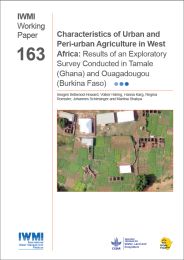Characteristics of urban and peri-urban agriculture in West Africa: results of an exploratory survey conducted in Tamale (Ghana) and Ouagadougou (Burkina Faso)
Citation:
Bellwood-Howard, I.; Häring, V.; Karg, H.; Roessler, R.; Schlesinger, J.; Shakya, M. 2015. Characteristics of urban and peri-urban agriculture in West Africa: results of an exploratory survey conducted in Tamale (Ghana) and Ouagadougou (Burkina Faso). Colombo, Sri Lanka: International Water Management Institute (IWMI). 38p. (IWMI Working Paper 163). [doi: 10.5337/2015.214]
Abstract
The report summarizes key results from surveys carried out on urban and peri-urban agriculture (UPA) in Tamale (Ghana) and Ouagadougou (Burkina Faso) in 2013. The aim was to provide a broad overview of the state of UPA in the study cities and a basis for future research endeavors. The randomized sampling approach used aerial photography to identify 10 sites in different categories of farm in each city. Farmers provided information on their cropping and livestock-rearing activities. There were similarities between the cities, but the differences in the expression of UPA in Tamale and Ouagadougou were more intriguing, as in farm sizes, crops grown and livestock ownership. Farmers were particularly concerned about diminishing access to land in Tamale, where sales by chiefs to private investors were accelerating. In Ouagadougou, formal reallocation of land to homeowners by the state had similarly decreased available farmland. Water availability was a universal concern, and the quality of water used for irrigation was potentially more questionable in Ouagadougou than in Tamale. The results point to the need for further work on uncontaminated, perennial water sources and soil fertility management, alongside focuses on commercialization of animal production, and the legal, political and institutional context of UPA in different West African cities.
ISSN 2012-5763
e-ISSN 2478-1134
ISBN 978-92-9090-821-0


